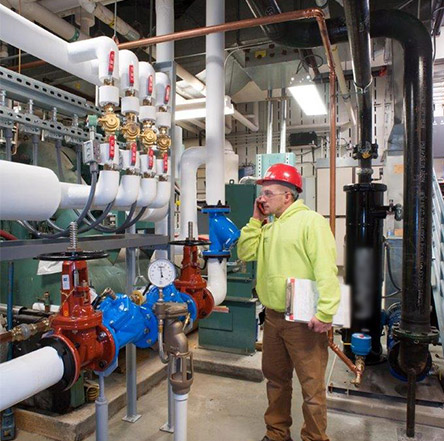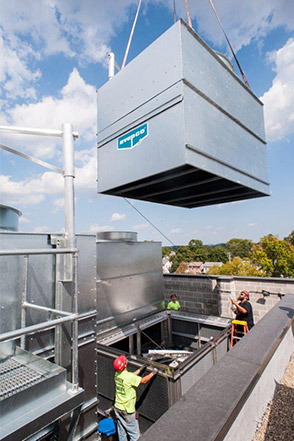
Only EVAPCO, Inc. had cooling towers with a small-enough footprint, yet large-enough capacity, to meet WellSpan Gettysburg Hospital’s need for upgraded towers that would lend themselves to future expansion. Manchester, PA-based James Craft & Son Inc. worked closely with EVAPCO to find the perfect solution to a challenging installation.
No Room for Error
Civil War-era physicians and nurses could only have dreamed of the contemporary health care facility that now stands within sight of the Gettysburg National Military Park. WellSpan Gettysburg Hospital was first constructed in 1921 and has since undergone several facility improvements and enhancements to patient care. Today, it is a nationally recognized acute care community hospital.
According to Joe Lehigh, a 27-year member of the facility’s engineering team, the hospital needed “to modernize mechanical systems that would assure reliability of critical patient care functions. High on the list was cooling equipment that had close ties to operation of our clinical and catheterization labs, sterilizing, the critical care department, operating rooms, and maternity ward functions—all with no room for errors that could lead to downtime.”
Maintaining reliability of the hospital’s indoor environments—and the ability to shed heat from cleaning and sterilization—took precedence over energy efficiency. But, said Lehigh, “We needed unerring dependability of critical patient care. We expected the rest to follow suit.”
Cooling Towers Top the List
“Replacement of the towers was a five-year effort,” explained Lehigh. “Early on, we identified a need and began preparations. At first, we considered a retrofit to the existing, 30-year-old cooling towers. Another approach would be to replace some of the evaporative coolers. But after careful evaluation, in an effort that actually took several years and through many budget cycles, it was clear to us that we needed to replace the old evaporative coolers.”
Lehigh said that the team of managers and outside experts tasked with finding a solution to the hospital’s needs all focused on the importance of improving cooling tower operations. Then, related mechanical equipment challenges would need attention as well.
“It felt at times like trying to assemble a jigsaw puzzle, not knowing if we had all the pieces,” added Lehigh. “The old cooling towers, with 900 tons of cooling capacity, were reparable—at least some of them were—but at considerable cost. Plus, there was the need for ongoing maintenance. New cooling towers offered many advantages, yet the higher price tag became the obstacle.”
Through the years of studying all aspects of the project’s “pieces,” the completed puzzle began to take shape when the hospital considered the many long-term advantages of improved energy efficiency, greatly reduced maintenance, improved operational performance, the ability to have redundancy, and capacity for hospital expansion.
Finding the Right Fit
The existing cooling towers were contained by brick walls on all sides, defining the footprint. WellSpan Health Engineering managers formulated a plan to replace the failing equipment in the same footprint and provide additional capacity for N+1 redundancy. Only one manufacturer, EVAPCO, had products that would meet the need for 1,200 tons of evaporative cooling equipment and also fit within the limits of the space. The existing cooling towers were connected to three, 300-ton York/Johnson Controls centrifugal chillers. The new coolers would have to have additional capacity for a new, 300-ton chiller needed for the hospital’s anticipated expansion.
“At EVAPCO, we were introduced to a team of folks who took our challenges seriously, and helped us find just the solution we were looking for. . . . No other manufacturer could do this for us.”
—Allan Jordan, Jobsite Supervisor, Craft & Son
Valuable Visit
Craft & Son brought a healthy attitude to the project. “Sure, there were challenges, but what job doesn’t throw a surprise occasionally?” said Allan Jordan, jobsite supervisor with Craft & Son. Furthermore, Jordan said, “We’ve worked with [EVAPCO] systems a lot in the past, and their ability to offer a custom solution to meet the hospital’s needs went a long way.”
A visit to EVAPCO’s plant in Maryland provided Craft & Son new insights and a source of solutions. “At EVAPCO, we were introduced to a team of folks who took our challenges seriously, and helped us find just the solution we were looking for.” said Jordan. “EVAPCO was able to offer a modular approach that permitted greater cooling capacity within the given footprint.
“The day we spent there was so valuable,” Jordan continued. “After seeing the complexity of the challenge, to find the answers so close to home, and with all of the professionals on our team nodding in appreciation . . . that was the moment when we knew we’d be able to accomplish the task we’d set out to do.
“No other manufacturer could do this for us,” Jordan noted.
Evaporative Solution
Specified for the hospital were two EVAPCO AT series, induced-draft, counterflow cooling towers, rated for 2,063 maximum gallons per minute (gpm), each with two modular, 300-ton (six-million BTU) cells, for a total of 1,200 tons or 14.4 million BTUs of evaporative cooling capacity. A key advantage is that these coolers have the smallest footprint in the industry for their size.
Each AT cooling tower provides external access to fully enclosed motors and belts. Attached to the motors is the company’s heavy-duty Power-Band drive system with aluminum alloy sheaves and pillow block bearings that provide a minimum guaranteed life of 75,000 hours, as well as and an aluminum alloy, statically-balanced, variable-frequency-drive-controlled, 25-horsepower fan.
The Gettysburg cooling towers also have galvanized steel access ladders and platforms, ideal for service and maintenance work. They provide easy access to fan motors and water distribution components.
“With EVAPCO, the ease of service and maintenance is a big improvement over our previous system. Before, we had to crawl into our old units to maintain them. Now, everything’s available from the exterior,” said Lehigh.

Prefabbed and Prepped
Despite unexpected warm weather on installation day in September of 2016, Craft & Son was prepared. “Allan [Jordan] informed me that, because of all the prefab work they did at the shop, they needed only one welded joint on installation day,” said Lehigh. “His technicians had already prepared and installed as much of the 14” condensing system supply-and-return piping, onsite, as they could, with every other component considered for prefab,” he continued. “They also installed most of the necessary piping for expansion of the hospital—ready for when that day arrives.”
Redundancy Plus Efficiency
“In reality, there are four [new] cooling towers, not two,” said Jordan. “Each ‘module’ acts as its own system. They’re identical, separate, and singly functional. There are four fans, four sets of valves, and four level controllers.”
On a given day, the facility may need only 900 tons of cooling capacity, but a full cell is available for redundancy, as well as to ensure peak efficiency of the entire system by modulating the fan speeds. Electric controls connect all facets of the mechanical system, and they constantly assess the variables and make decisions to ensure dependability.
The control system also selects system function for maximum energy efficiency. For instance, conditions may call for operation of one cell (or modular evaporator section) at 100 percent. Instead, two cells are tapped at 50 percent each. In addition to energy savings, tower fan speeds can be lowered to reduce wear on motors, belts, and bearings.
EVAPCO’s independent water level control and isolation valves allow operators to easily lock out individual towers as needed and to generate an alarm to the building management system. Each module can be isolated easily, allowing other systems to ramp up to replace any part of the system that is shut down temporarily for routine maintenance. In a failure scenario, the control system can automatically shut that cell down, lock it out, and then notify technicians that service work is required.
Systems Come Together
In the bowels of the hospital are the chillers and water treatment equipment and the pump stations that circulate fluids to and from all of the connected equipment. Included are three 945-gpm Taco base-mounted cooling tower condenser pumps and three 756-gpm base-mounted pumps to govern constant flow of chilled water to and from the hospital’s 22 air handling units, from 10 to 120 tons in size.
“Important, sometimes life-saving work goes on every day in any of the floors above us,” noted Lehigh. “Yet, down here—and, now, out on the rooftop—are the new and improved systems that make it all possible. A lot of planning, and a lot of work, and the right systems all came together.
“Now we know that the facility’s ultimate mandate—no downtime—is as close to a full guarantee as we can make it,” he concluded.
For more information, visit www.evapco.com.


